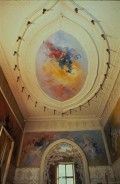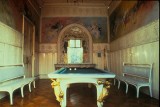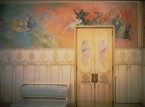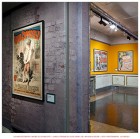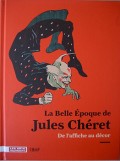The browser will either open the file, download it, or display a dialog.
La Belle Époque de Jules Chéret: de l'Affiche au décor
Les Arts Décoratifs, Paris
June 24 – November 7, 2010
Museum Villa Stuck, Munich
November 10, 2011 – February 4, 2012
Musée Toulouse-Lautrec, Albi
Second part of 2012 (no specific dates confirmed)
Catalogue:
La Belle Époque de Jules Chéret. De l'affiche au décor
Publication under the direction of Réjane Bargiel and Ségolène Le Men
Paris: Les Arts Décoratifs and Bibliothèque nationale de France, 2010.
366 pp.; 1600 illustrations, bibliography, catalogue raisonné of Chéret's work, index
59 €
ISBN: 978-2-916914- 14-5
When Roger Marx, one of the leading art critics at the end of the nineteenth century, commented on the work of Jules Chéret he did so with full confidence that Chéret was the artist who had modernized posters, recognizing an artistic medium capable of reaching and educating the general public.[1] The importance of Chéret's use of color posters, as the extensive monographic exhibition at the Musée des Arts Décoratifs in Paris makes amply clear, demonstrates how artistic events—spectacles "en tout genre," new books and magazines, new products in commerce and industry—would reach an ever expanding public (fig. 1).
Posters by Chéret, called the king of posters, covered Parisian walls during the 1880s and beyond, encouraging a passion for "affichomania," a term coined at the time to document the proliferation of posters in public areas and, more generally, the evolution of the poster industry. Following Chéret's example, and success, many other artists of the period created, or were asked to create, their own posters to meet the increasing demand of the growing commercial advertising industry. Further, the subtlety of Chéret's creations, which critics linked to eighteenth-century artists, such as François Boucher, made him so sought after that he had to enlist a stable of designers and artisans to help him meet the demands for his art works.[2] By continually and aggressively increasing the level of awareness of posters in the print world, Chéret helped raise posters into a fine art, equal to painting, sculpture or architecture. As commissions for new posters poured in, art dealers (e.g., Sagot) as well as collectors recognized the creative future of the medium; it democratized art, demonstrating that posters were, indeed, an art nouveau.
Beyond establishing the importance of Chéret, the poster-maker, the Musée des Arts Décoratifs exhibition had another goal: to demonstrate that there were subtle links among poster making, design, and the creation of elegant interiors (fig. 2). To achieve this, the first rooms of the exhibition were given to spaces where Jules Chéret had used many of the same figures found in his posters in pastels and paintings for room interiors destined for his friends, such as Baron Joseph Vitta.[3] In doing so, the exhibition revealed that Chéret was much more than a poster maker (fig. 1). He was an interior designer whose works were sought after by wealthy friends and municipal governments, such as Paris and Nice (where Chéret had a home). Since room interiors could not be reconstituted in the installation, the show organizers, Réjane Bargiel and Ségolène Le Men, relied on a short film to show the Evian interior for Baron Vitta (fig. 3). The gallery also included pastel sketches of various wall paintings for Evian obtained from the Jules Chéret museum in Nice. (fig. 4). The billiard room—the decorative centerpiece at La Sapinière in Evian—includes works by Félix Bracquemond, Auguste Rodin and Félix Charpentier to form a decorative ensemble, which reveals Jules Chéret was perceived as a serious and versatile artist within the design community (figs. 5, 6, and 7). His fame would make him attractive to furniture designers—albeit with some reluctance on their part—and even to the stately Gobelins Tapestry Manufactory in Paris. In fact Chéret, along with others, forced Gobelins to revitalize itself under the stimulation of progressive ideas.[4] Significantly, Chéret's position as a creator was explored early in this exhibition, challenging the standard belief that he was only a designer of prints, rather than an artist who worked effectively in several media simultaneously.
As it unfolded, the exhibition documented the many facets and variants of Chéret's work. Early states of a poster "before letters" revealed how he worked on mastering his designs; other versions of a poster documented how his use of color made his images come alive. By placing the works next to one another in the installation, the organizers gave visitors a very good idea of the evolution of a print from its original inception to its final resolution (fig. 8).
Another of the most significant aspects of the show was the way in which Chéret's early work, including his commercial designs done in England, were presented. In these works from the 1870s, the viewer was introduced to Chéret the young commercial artist who created flower prints for perfume advertisements while he was still learning his trade. The huge number, and variety of works that Chéret produced was emphasized, providing a clear idea of the ways in which he worked even before he was able to fully present his more original designs.
The installation presented some of Chéret's posters in a way that recreated how they were actually seen on the streets of Paris. His placard for Charles Dicken's David Copperfield (fig. 9)—as well as other posters exhibited in the hallway separating the two sides of the exhibition spaces—was shown against the illusion of an actual wall with partially decaying bricks. This imaginative way of showing visitors how posters originally were seen reinforced the idea that posters were meant to popularize the availability of editions of well-known books by Charles Dickens, Victor Hugo, Eugène Sue, and Émile Zola, thus making the masses aware of the novels. These posters also established Chéret's public visibility, attracting more commissions beyond his already successful advertising projects.
By the 1890s, Chéret's creation of a delicate, young, fashionable woman, frequently identified as a "Cherrette" by critics, became one of the hallmarks of his poster style. An attractive girl was used to help sell "Saxoleine" for lighting purposes; another variant of this model helped promote soap, wines, hair coloring, cigarettes, and Ed. Sagot's print gallery where Chéret's posters were attracting serious attention from collectors (see fig. 8). Viewing many of these images together in one gallery not only documents the profusion of posters, but also highlights how Chéret's fashionable women became incarnations of a dream state. This visual intoxication, both in the exhibition and, we are made to understand on Parisian walls, helped sell products then and now.
An integral part of the exhibition, in addition to the very carefully prepared wall texts, is the catalogue (fig. 10). Each of the essays in this book examined crucial issues in Chéret's work: the way in which his street art was compared with paintings at the yearly Salon exhibitions; his beginnings in commercial design; the types of art work he created and the resonance his objects had; Chéret's interest in interior decoration and his involvement with private patrons and official organizations, such as the Gobelins tapestry manufactory, and, finally, Chéret's reception by critics, especially by Roger Marx and Gustave Kahn. Each section is carefully integrated with the others to create a cohesive publication that brilliantly evokes the period in which Chéret worked while, at the same time, giving ample room for discussion of individual works of art. One of the most impressive parts of this publication remains the catalogue raisonné of Chéret's posters arranged thematically at the end of the book. Completing the work of previous scholars, Ernest Maindron (1896) and Lucy Broido (1992), this catalogue section contains 1,430 numbers, which unites the posters held by the Musée de la Publicité with those of the Bibliothèque Nationale de France, the collection Gustave Dutailly in Chaumont, France, as well as the Jack Rennert in New York, will be of continuous use now and in the future. The essays, written by Anne-Marie Sauvage, Noriko Yoshida, and especially by Réjane Bargiel and Ségolène Le Men, provide a model for other exhibition catalogues. Developed with care, insight, intelligence, and demonstrating a comprehensive knowledge of the period, as well as Chéret's work itself, this catalogue helps reinforce the impression that this is one of the most important exhibitions in recent memory that united all phases of the artist's production so that the career and work of Jules Chéret can be studied and understood in a much clearer light.
Gabriel P. Weisberg
University of Minnesota
Vooni1942[at]aol.com
[1]Roger Marx, un critique aux côtés de Gallé, Monet, Rodin, Gauguin… ex. cat. (Nancy: Ville de Nancy and Éditions Artlys, 2006). Also see Noriko Yoshida, "Jules Chéret et la critique d'art de Roger Marx à Gustave Kahn", in La Belle Époque de Jules Chéret. De l'affiche au décor, ex. cat. (Paris: Les Arts Décoratifs and Bibliothèque nationale de France, 2010): 109-119.
[2] See Réjane Bargiel, "Jules Chéret décorateur," in La Belle Époque de Jules Chéret. De l'affiche au décor (2010): 88.
[3] On Vitta and La Sapinière see Gabriel P. Weisberg, "The Villa of Baron Vitta," Antiques World 1, no. 7 (May 1979): 76-84.
[4] Ibid.: 99-103.





